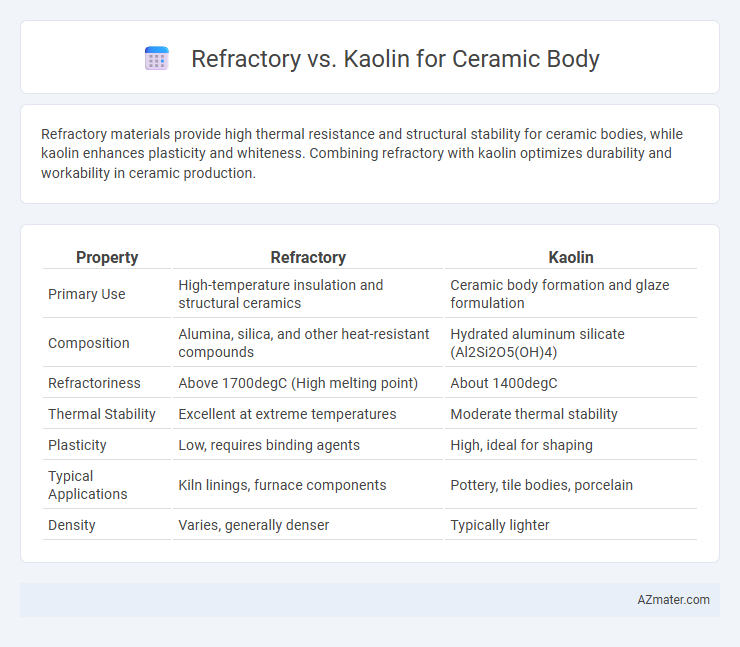Refractory materials provide high thermal resistance and structural stability for ceramic bodies, while kaolin enhances plasticity and whiteness. Combining refractory with kaolin optimizes durability and workability in ceramic production.
Table of Comparison
| Property | Refractory | Kaolin |
|---|---|---|
| Primary Use | High-temperature insulation and structural ceramics | Ceramic body formation and glaze formulation |
| Composition | Alumina, silica, and other heat-resistant compounds | Hydrated aluminum silicate (Al2Si2O5(OH)4) |
| Refractoriness | Above 1700degC (High melting point) | About 1400degC |
| Thermal Stability | Excellent at extreme temperatures | Moderate thermal stability |
| Plasticity | Low, requires binding agents | High, ideal for shaping |
| Typical Applications | Kiln linings, furnace components | Pottery, tile bodies, porcelain |
| Density | Varies, generally denser | Typically lighter |
Introduction to Ceramic Materials
Refractory materials, known for their high melting points and thermal stability, are essential in ceramic body formulations requiring resistance to extreme heat and mechanical stress. Kaolin, a primary clay mineral, provides plasticity, whiteness, and thermal resistance, making it vital for shaping and firing delicate ceramic products. Understanding the distinct properties and functions of refractory versus kaolin components enables optimized ceramic body development for specific industrial and artistic applications.
Understanding Refractory Clays
Refractory clays contain high amounts of alumina and silica, providing excellent heat resistance and structural integrity in ceramic bodies subjected to extreme temperatures. Kaolin, a primary clay mineral rich in kaolinite, offers plasticity and whiteness but lacks the high refractory properties necessary for high-temperature applications. Understanding the mineralogical composition and thermal behavior of refractory clays versus kaolin is essential for optimizing ceramic formulations used in kiln linings and other heat-intensive environments.
What is Kaolin Clay?
Kaolin clay is a primary component in ceramic body formulations, valued for its fine particle size, high purity, and excellent plasticity. Unlike refractory materials, which are designed to withstand extremely high temperatures, kaolin clay contributes to the strength, whiteness, and smooth texture of ceramics during firing. This aluminosilicate mineral improves the workability and fired characteristics of ceramic products, making it essential for porcelain and fine china production.
Key Differences Between Refractory and Kaolin
Refractory materials are designed to withstand high temperatures and thermal shock, making them essential for kiln linings and furnace applications, whereas kaolin is primarily a fine white clay used as a primary ingredient in ceramic bodies for improving plasticity and whiteness. Refractory materials typically contain alumina and silica in higher proportions, providing superior heat resistance and mechanical strength compared to kaolin, which has lower refractory properties but contributes to the workability and smooth surface finish of ceramics. The key differences lie in their thermal stability, chemical composition, and functional roles within ceramic formulations, with refractories serving structural and insulating purposes and kaolin enhancing forming and aesthetic qualities.
Thermal Properties Comparison
Refractory materials exhibit higher thermal resistance and can withstand temperatures exceeding 1,700degC, making them ideal for high-fire ceramic bodies. Kaolin, with its lower thermal expansion and melting point around 1,750degC, provides enhanced thermal stability and shrinkage control but is less resistant to extreme heat compared to refractory substances. The choice between refractory and kaolin depends on balancing thermal shock resistance, firing temperature, and mechanical strength in ceramic body formulations.
Impact on Ceramic Body Strength
Refractory materials enhance ceramic body strength by providing high resistance to thermal shock and maintaining structural integrity at elevated temperatures, which reduces cracking and deformation during firing. Kaolin contributes to ceramic strength by promoting vitrification and plasticity, improving particle bonding and mechanical durability after firing. Combining refractory minerals with kaolin optimizes the ceramic body's overall strength by balancing thermal stability and cohesive properties.
Firing Temperature Requirements
Refractory materials withstand higher firing temperatures above 1400degC, making them ideal for high-temperature ceramic bodies like porcelain and stoneware. Kaolin, with a lower melting point around 1200degC to 1300degC, suits mid-range firing temperatures typical in earthenware and some porcelain formulations. Choosing between refractory and kaolin depends on the desired firing temperature range and the specific ceramic body's vitrification needs.
Applications in Ceramic Manufacturing
Refractory materials offer high thermal stability and resistance to chemical corrosion, making them essential in kiln linings and industrial furnaces within ceramic manufacturing. Kaolin, a primary source of alumina and silica, enhances plasticity and whiteness in ceramic bodies, improving the quality and finish of tableware, tiles, and sanitaryware. The choice between refractory and kaolin hinges on the specific properties required, such as high-temperature resistance or optimal workability and aesthetic appeal.
Cost and Availability Factors
Refractory materials typically offer higher heat resistance but come with increased cost and limited availability compared to kaolin, which is more abundant and economically accessible for ceramic body formulation. Kaolin's widespread extraction and lower price make it a preferred choice for mass production, while refractory clays are reserved for specialty ceramics requiring enhanced thermal durability. Cost-efficiency and accessibility of raw materials directly influence production scale and ceramic body performance attributes.
Choosing the Right Clay for Your Ceramic Body
Refractory clay and kaolin serve distinct roles in ceramic bodies, with refractory clay offering superior heat resistance ideal for kiln linings and high-temperature applications, while kaolin provides exceptional whiteness and plasticity essential for fine porcelain and smooth finishes. Selecting the right clay depends on the desired thermal performance and aesthetic qualities; refractory clay withstands thermal shock and maintains structural integrity, whereas kaolin enhances workability and translucency. Understanding these differences ensures optimal functionality and appearance in ceramic products.

Infographic: Refractory vs Kaolin for Ceramic body
 azmater.com
azmater.com